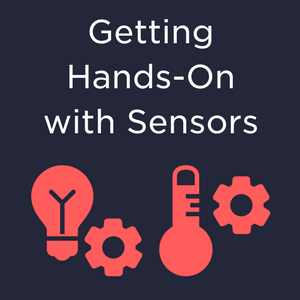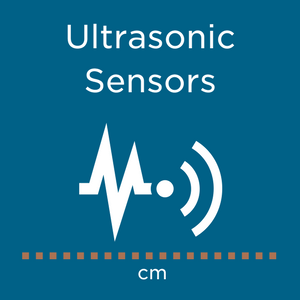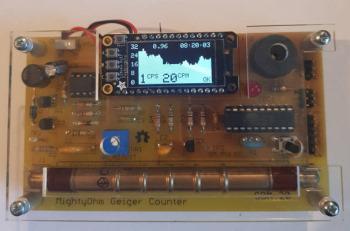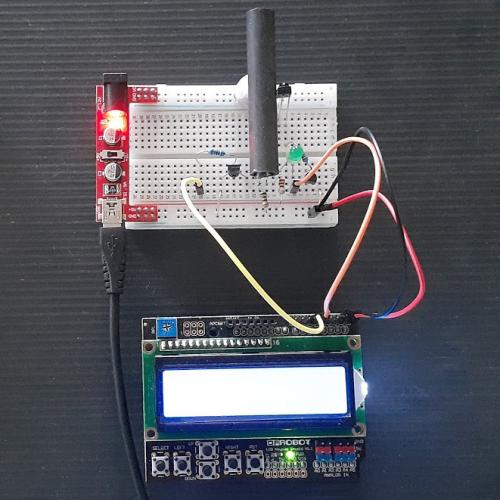Pololu Digital Distance Sensor v2 with Pulse Width Output, 50cm Max, Side-Entry Connector
Available with a lead time
Expect dispatch between Jun 23 and Jun 26
This compact sensor makes it possible to measure the distance of objects up to about 50 cm (20") away using a simple digital pulse width interface (similar to a hobby servo control signal). It uses a short-range lidar module to precisely measure how long it takes for emitted pulses of infrared, eye-safe laser light to reach the nearest object and be reflected back, allowing for 1 mm resolution. As long as the sensor is enabled, it takes continuous distance measurements and encodes the ranges as the widths of high pulses, which can then be timed by a microcontroller using a single digital input.
 |
 |
A camera with no IR filter shows the infrared light emitted by a Pololu Digital Distance Sensor (this light is eye-safe and not visible to the naked eye). |
|---|
The relationship between measured distance d (in mm) and pulse width t (in µs) is as follows:
d=3 mm4 µs·(t –1000 µs)
t=1000 µs+4 µs3 mm·d
The timing uncertainty is approximately ±5%. As objects approach the sensor, the output pulse width will approach 1.0 ms, while an object detected at 50 cm will produce a 1.667 ms pulse width. The sensor uses a pulse width of 2.0 ms to indicate no detection, and the pulse period T ranges from around 6 ms to 7 ms, depending on the proximity of the detected object.
The maximum detection range depends on object reflectivity and ambient lighting conditions. In Pololu's tests, the sensor was able to reliably detect a white sheet of paper out to around 50 cm away, and it could reliably detect a hand out to around 30 cm away. The following graph shows the measured distances of five units versus their actual distances from a white paper target at several different ranges:
 |
This sensor features a side-entry 3-pin male JST SH-style connector that works with Pololu's 3-pin JST SH-style cables. A functionally identical version is also available with 0.1"-pitch through-holes instead of a connector.
Specifications
 |
- Operating voltage: 3.0 V to 5.5 V
- Current consumption: 30 mA (typical) when enabled, 0.4 mA when disabled
- Maximum range: approximately 50 cm (20")
- Minimum range: < 1 mm
- Resolution: 1 mm
- Minimum update rate: 142 Hz (7 ms period)
- Field of view (FOV): 10° typical; can vary with object reflectance and ambient conditions
- Emitter: eye-safe, 940 nm invisible Class 1 VCSEL (vertical cavity surface-emitting laser)
- Output type: digital pulse width
- Connector: side-entry 3-pin male JST SH-style that is compatible with Pololu's 3-pin JST SH-style cables
- Dimensions: 0.9" × 0.35" × 0.2" (22.9 × 8.9 × 5.2 mm); see the dimension diagram (286k pdf) for more information
- Weight: 0.02 oz (0.5 g)
Using the sensor
 |
Important note: This product might ship with a protective liner covering the sensor IC. The liner must be removed for proper sensing performance.
Three connections are necessary to use this module: VIN, GND, and OUT. These pins are accessible through a row of 0.1"-pitch through holes, which work with standard 0.1" (2.54 mm) male headers and 0.1" female headers (available separately). The VIN pin should be connected to a 3 V to 5.5 V source, and GND should be connected to 0 volts. The sensor outputs its digital pulses on the OUT pin. The low level of the pulses is 0 V, and the high level is VIN. A red LED on the back side of the board also lights whenever an object is detected (the closer the object, the brighter the LED).
 |
The board has an optional ENABLE pin that can be driven low to put it into a low-power state that consumes approximately 0.4 mA. This pin can be accessed through a via or its neighboring surface-mount pad on the back side labeled “EN” on the silkscreen. The ENABLE pin is pulled up to VIN, enabling the sensor by default.
The board has one mounting hole intended for use with #2 or M2 screws.
Arduino program for reading pulse width output
This is a simple Arduino sketch that reads the output of the Pololu Distance Sensor with Pulse Width Output, 50cm Max and displays the measured distance in millimeters.
| 1 2 3 4 5 6 7 8 9 10 11 12 13 14 15 16 17 18 19 20 21 22 23 24 25 26 27 28 29 30 31 32 33 34 35 36 | // Example Arduino program for reading the Pololu Distance Sensor with Pulse Width Output, 50cm Max// Change this to match the Arduino pin connected to the sensor's OUT pin.constuint8_t sensorPin = 2;voidsetup(){ Serial.begin(115200);}voidloop(){ int16_t t = pulseIn(sensorPin, HIGH); if(t == 0) { // pulseIn() did not detect the start of a pulse within 1 second. Serial.println("timeout"); } elseif(t > 1850) { // No detection. Serial.println(-1); } else { // Valid pulse width reading. Convert pulse width in microseconds to distance in millimeters. int16_t d = (t - 1000) * 3 / 4; // Limit minimum distance to 0. if(d < 0) { d = 0; } Serial.print(d); Serial.println(" mm"); }} |
micro:bit MakeCode program for reading pulse width output
Pololu have also created a MakeCode example program for the BBC micro:bit single-board computer that demonstrates how to read and convert the output of the Pololu Distance Sensor with Pulse Width Output, 50cm Max. The program’s output can be viewed in the MakeCode device console, which also plots the readings on a graph. You can open the program in the micro:bit MakeCode editor by clicking this link or the picture below.
Jumper settings for v2 short-range versions
 |
This board features four surface-mount configuration jumpers that determine its operation mode. Different versions of the Pololu Digital Distance Sensors ship with the appropriate jumpers pre-populated with 0 O resistors. These resistors can be desoldered from the populated spots or solder bridges can be added across the unpopulated spots to convert one sensor version into another. This sensor can be converted into any other v2 short-range version as listed in the following table. (For more information about how the different output types work, see the product pages for representative versions.)
| V2 short-range version jumper settings | |||||||
| Item # | Description | Maximum range(1) | Hysteresis | Resolution | Minimum update rate | Jumper settings (4321) | |
|---|---|---|---|---|---|---|---|
| no connector | side-entry connector | ||||||
| #5550 | #5460 | Digital output, 5cm | 5 cm | 35 mm | - | 142 Hz | 0000 |
| Digital output, 5cm (high sensitivity) | 5 cm | 21 mm | - | 66 Hz | 0001 | ||
| #5552 | #5462 | Digital output, 10cm | 10 cm | 35 mm | - | 142 Hz | 0010 |
| Digital output, 10cm (high sensitivity) | 10 cm | 21 mm | - | 66 Hz | 0011 | ||
| #5554 | #5464 | Digital output, 15cm | 15 cm | 35 mm | - | 142 Hz | 0100 |
| Digital output, 15cm (high sensitivity) | 15 cm | 21 mm | - | 66 Hz | 0101 | ||
| Digital output, 20cm | 20 cm | 35 mm | - | 142 Hz | 0110 | ||
| Digital output, 20cm (high sensitivity) | 20 cm | 21 mm | - | 66 Hz | 0111 | ||
| Digital output, 30cm | 30 cm | 35 mm | - | 142 Hz | 1000 | ||
| Digital output, 30cm (high sensitivity) | 30 cm | 21 mm | - | 66 Hz | 1001 | ||
| Digital output, any detect | ~100 cm | - | - | 142 Hz | 1010 | ||
| Digital output, any detect (high sensitivity) | ~100 cm | - | - | 66 Hz | 1011 | ||
| #5562 | #5472 | Pulse width output, 50cm max | ~50 cm | - | 1 mm (= 1.33 µs) | 142 Hz | 1100 |
| Pulse width output, 50cm max (high sensitivity) | ~50 cm | - | 1 mm (= 1.33 µs) | 66 Hz | 1101 | ||
| Pulse width output, 100cm max | ~100 cm | - | 1 mm (= 0.5 µs) | 142 Hz | 1110 | ||
| Pulse width output, 100cm max (high sensitivity) | ~100 cm | - | 1 mm (= 0.5 µs) | 66 Hz | 1111 | ||
| Note 1: Effective range depends on object reflectivity and ambient lighting conditions. | |||||||
Item numbers in this table indicate versions that Pololu offer for sale as standard products, but Pololu can manufacture the other versions on demand (or even make sensors with custom firmware for you). If you are interested in customization, please contact us.
The Pololu Digital Distance Sensor family
Pololu have several versions of Pololu Digital Distance Sensors with different ranges, operating modes, and connector options:
| High/low digital output (indicates detection within specified range; does not provide distance measurement) | |||||||
| Sensor type | Item # | Maximum range(1) | Minimum range | Hysteresis | Minimum update rate | ||
|---|---|---|---|---|---|---|---|
| no connector | side-entry connector | ||||||
| original short-range (irs16a) | #4050 | 5 cm | < 5 mm | 16 mm | 145 Hz | ||
| #4052 | 10 cm | 20 mm | 115 Hz | ||||
| #4054 | 15 cm | 24 mm | 95 Hz | ||||
| v2 short-range | #5550 | #5460 | 5 cm | < 1 mm | 35 mm | 142 Hz | |
| #5552 | #5462 | 10 cm | |||||
| #5554 | #5464 | 15 cm | |||||
| long-range | #4066 | #5480 | 25 cm | < 1 mm | 50 mm | 100 Hz | |
| #4067 | #5481 | 50 cm | 100 Hz | ||||
| #4069 | #5483 | 100 cm | 100 Hz | ||||
| #4077 | #5491 | 200 cm | 30 Hz | ||||
| Pulse width output (provides distance measurement encoded as the width of a digital pulse) | |||||||
| Sensor type | Item # | Maximum range(1) | Minimum range(2) | Resolution | Minimum update rate | ||
| no connector | side-entry connector | ||||||
| original short-range | #4064 | ~50 cm | 1 cm | 3 mm (= 4 µs) | 50 Hz | ||
| v2 short-range | #5562 | #5472 | ~50 cm | < 0.1 cm | 1 mm (= 1.33 µs) | 142 Hz | |
| long-range | #4071 | #5485 | ~130 cm | 4 cm | 1 mm (= 0.5 µs) | 100 Hz | |
| #4079 | #5493 | ~300 cm | 4 cm | 2 mm (= 0.5 µs) | 30 Hz | ||
| Note 1: Effective range depends on object reflectivity and ambient lighting conditions. Note 2: Objects closer than the minimum distance can still be detected, but the measured distance might be inaccurate. The minimum detection distance is < 5 mm for the original (irs16a) short-range sensors and < 1 mm for everything else. | |||||||
The Pololu Digital Distance Sensor family includes several different sensor types. The jumper options are different for the different sensor types, so it is important to be able to identify which type you have if you want to change the jumper settings. The following diagram shows some key visual differences among the different sensor types:
 |
Comparison of the different Pololu Digital Distance Sensor versions. |
|---|
Within each sensor type, there are digital output versions that just report if an object is within their detection range and pulse width output versions that report the measured distance by encoding it as the width of a repeating digital pulse, similar to hobby servo control signals. The graphs below show some examples of the different possible output signals from the different Pololu Digital Distance Sensor versions.
Comparison to Sharp/Socle Digital Distance Sensors
These Pololu Digital Distance Sensors have the same general form factor and pinout as Pololu's carrier boards for the Sharp/Socle GP2Y0D8x digital distance sensors (the versions with through-holes have the same length and width while the versions with JST SH-style connectors are 0.05" longer). They are available in the same 5 cm, 10 cm, and 15 cm ranges as the Sharp/Socle sensors, in addition to longer ranges of up to several meters. This means they can be used as replacements for these older modules, which are based on sensors that are no longer in production, and the longer-range versions can serve as upgrades that provide enhanced detection and measurement capabilities. The sensors on these newer units are much thinner than the Sharp modules, so the zero-range point is approximately 7 mm closer to the PCB, and the beam angle of the newer units is wider. The pictures below show side-by-side comparisons of the two:
|
|
|
Dimensions
| Size: | 0.9" × 0.35" × 0.2" |
|---|---|
| Weight: | 0.5 g |
General specifications
| Maximum range: | 50 cm |
|---|---|
| Update rate: | 142 Hz1 |
| Minimum operating voltage: | 3.0 V |
| Maximum operating voltage: | 5.5 V |
| Connector: | side-entry, 3-pin JST SH-type |
| Supply current: | 30 mA2 |
| Output type: | digital pulse width |
Identifying markings
| PCB dev codes: | irs17b |
|---|---|
| Other PCB markings: | 0J15469 or 0J15601 |
Notes:
- 1
- Minimum.
- 2
- Typical average current draw when enabled; disabling via the EN pin reduces it to around 0.4 mA.
File downloads
Dimension diagram of the Pololu Digital Distance Sensor v2 with Side-Entry Connector (286k pdf)
3D model of the Pololu Digital Distance Sensor v2 with Side-Entry Connector (4MB step)
Drill guide for the Pololu Digital Distance Sensor v2 with Side-Entry Connector (13k dxf)
This DXF drawing shows the locations of all of the board’s holes.
Recommended links
Exact shipping can be calculated on the view cart page (no login required).
Products that weigh more than 0.5 KG may cost more than what's shown (for example, test equipment, machines, >500mL liquids, etc).
We deliver Australia-wide with these options (depends on the final destination - you can get a quote on the view cart page):
- $3+ for Stamped Mail (typically 10+ business days, not tracked, only available on selected small items)
- $7+ for Standard Post (typically 6+ business days, tracked)
- $11+ for Express Post (typically 2+ business days, tracked)
- Pickup - Free! Only available to customers who live in the Newcastle region (must order online and only pickup after we email to notify you the order is ready). Orders placed after 2PM may not be ready until the following business day.
Non-metro addresses in WA, NT, SA & TAS can take 2+ days in addition to the above information.
Some batteries (such as LiPo) can't be shipped by Air. During checkout, Express Post and International Methods will not be an option if you have that type of battery in your shopping cart.
International Orders - the following rates are for New Zealand and will vary for other countries:
- $12+ for Pack and Track (3+ days, tracked)
- $16+ for Express International (2-5 days, tracked)
If you order lots of gear, the postage amount will increase based on the weight of your order.
Our physical address (here's a PDF which includes other key business details):
40 Aruma Place
Cardiff
NSW, 2285
Australia
Take a look at our customer service page if you have other questions such as "do we do purchase orders" (yes!) or "are prices GST inclusive" (yes they are!). We're here to help - get in touch with us to talk shop.
Have a product question? We're here to help!
Videos
View AllGuides
The Maker Revolution
Getting Hands-on with Sensors
How to Use Ultrasonic Sensors
Projects
WhyzaGC - Feather ESP32 addon to the MightyOhm Gieger Counter
IR Break-Beam Stopwatch
Makers love reviews as much as you do, please follow this link to review the products you have purchased.





















Product Comments